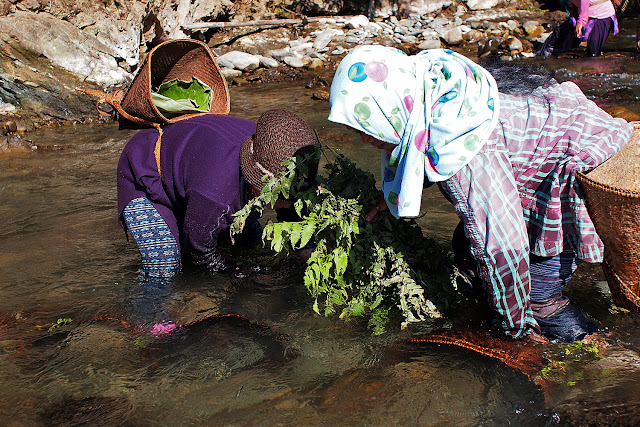I belong to (Adi) Galo tribe of Arunachal Pradesh, India.
Our community from the village owns this river bed and they fish in group once every 2/3 years now.
Earlier fishing used to be yearly but due to over fishing, there are hardly any good catch now so the village elders has come to the decision that fishing should be done once every 2/3 years. It is a community (private) river so people from other community of the same village and people from other villages are not allowed to fish here. Also people from the same community cannot fish in single or groups other than this time of the year.
Since it is an infrequent event, the entire community comes in a large group sometimes bringing in friends and relatives from same or other villages which is allowed during this time.
The photos were taken during December 2014. Winter is the time when the water is low and fishing is easy. During Summer and monsoon the water level rises making it dangerous to fish.
The above is a wild berry with thorny leaves. We call it Achin Parin. It is sweet and sometimes sour. It doesn't have much flesh to eat, It just looks pretty.
Crossing dried paddy fields...
A typical Galo (Tani tribe) farm house, called Nakum which is used as a rest house during farming and it is just a mini version of a real Galo tribal house.
Climbing the hill... the community river was kind of far away...
Reached at last but still we had to cross this small stream to get across the resting bank.
Washing utensil and cups to make tea for all.
Making food for all.
Women keeping their valuables like phones, etc at a safe place before going into the river.
This is a traditional backpack carried by men.
My mother (Ane)
Cousin sister
It's as not easy as it looks. The water is chilly because it is winter and having to pick stones for long hours hurts the fingers a lot!
It is a serene place...
Situ is carrying a conical basket with larger holes in the bottom for fishing and a small cane basket across her waist to keep the fishes. Fishes are not very big this part. Along with small fishes, small river shrimps are caught.
Having food before going in the water. Rice is served in "Okom" leaves with fish caught early and contributed by everyone and other green vegetables.
Warming up...
My mother (Ane) is carrying a conical basket weaved tightly called Sura without obvious holes which is not the fishing basket. It is a multi utility basket used to carry everything from utensils, wood, fish, vegetable, rice, etc...
Men are busy making a small diversion dam. They make this dam to change the course of river. They dry one side of the river and the women catch fish from the dried river. Also they use natural yellow colour toxic tree barks to kill the fish. The yellow bark is not harmful to human beings.
Two men fishing with bamboo fishing rods.
He is my uncle. He is preparing baskets for capturing fish.
Women eating before fishing.
This is the toxic tree bark which kills fish. It's beaten and then immersed in water.
He is my uncle, my father's twin older brother.
Traditional arrangements
The yellow toxic is spread into the water.
He is making sure the bark is fully absorbed.

Men are at pulping the bark.
 My Cousin brother fooling around.
My Cousin brother fooling around.

My cousin, puts his hand under the rock to remove a good catch.
Sorry, no photos of the catch.


























































































